My Grape Jelly Adventure
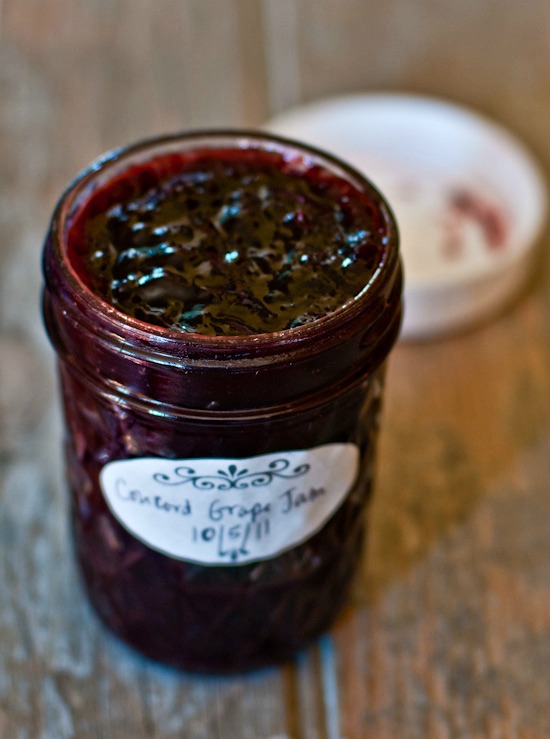 Hey all...Last week I took a fun class on canning. I'm told that as a beginner I should start with jelly's and jams as see how that goes. Well I've gathered up all the equipment, read me some books, and today I made me some Jelly...wohoo!! so excited. It seems to me that patience is a virtue when it comes to canning and or making jelly at least.. I started at about 2:30..2 hours later I'm sitting here typing waiting for the water in the canner to boil..hmmm. Am I doing something wrong..or am I just impatient?? I used grape juice concentrate, prepared it according to package and then followed all the instructions on the box Sure-Gel. I made grape my favorite...and my families favorite there's nothing better than warm biscuts with grape jelly or honey on top...yummy.. I'll post later and let everyone know if my jelly set up, and my lids popped...please..pop.. But I think the jelly will set up cause the drips and jelly on the stir spoon seemed pretty thick and sticky...a good sign I think!!
Hey all...Last week I took a fun class on canning. I'm told that as a beginner I should start with jelly's and jams as see how that goes. Well I've gathered up all the equipment, read me some books, and today I made me some Jelly...wohoo!! so excited. It seems to me that patience is a virtue when it comes to canning and or making jelly at least.. I started at about 2:30..2 hours later I'm sitting here typing waiting for the water in the canner to boil..hmmm. Am I doing something wrong..or am I just impatient?? I used grape juice concentrate, prepared it according to package and then followed all the instructions on the box Sure-Gel. I made grape my favorite...and my families favorite there's nothing better than warm biscuts with grape jelly or honey on top...yummy.. I'll post later and let everyone know if my jelly set up, and my lids popped...please..pop.. But I think the jelly will set up cause the drips and jelly on the stir spoon seemed pretty thick and sticky...a good sign I think!!How to Make Homemade Grape Jelly - Easily!
Related pages: See this page for How to make muscadine or scuppernong jelly or this page for Jam-making directions and this page for apple jelly directions!
For easy applesauce or apple butter directions, click on these links.
Ingredients
- Grapes - 5 lbs of fresh grapes, preferably fresh, but if you want to start with grape juice (5 cups bottled, without sugar added or reconstituted from frozen, without sugar), you can skip to step 7.
- Pectin - 1 package (box usually) or if you get it in bulk, 8 Tablespoons, see the directions below for specifics - (it's a natural product, made from apples and available at grocery stores (season - spring through late summer) and local "big box" stores. It usually goes for about $2.00 to $2.50 per box. You'll get best results with no-sugar needed pectin, whether you choose to add sugar or not! See here for more information about how to choose the type of pectin to use.
- Sugar - About 4.5 cups of dry, granulated (table) sugar, if you use the no-sugar-needed pectin (the only type I recommend) or low sugar pectin. If you use regular pectin, you'll need 7 cups of sugar. Of course, you can substitute honey, agave, stevia or Splenda; see the no-sugar recipe, click here.
Equipment
- Large spoons and ladles
- Jar funnel ($2 at Target, other big box stores, and often grocery stores; and available online - see this page) or order it as part of the kit with the jar grabber.
- Jar grabber (to pick up the hot jars)- Big box stores and grocery stores sometimes carry them; and it is available online - see this page. It's a tremendously useful to put jars in the canner and take the hot jars out (without scalding yourself!). The kit sold below has everything you need, and at a pretty good price:
- Blender, food processor or juicer - Yes, you could do it manually, if are only making a small batch, are insane, or you have access to child labor.
- At least 1 large pot; I prefer 16 to 20 quart Teflon lined pots for easy cleanup.
- Jelly strainer - see step 6 - or a colander and cheesecloth.
- 1 Canner (a huge pot to sanitize the jars after filling (about $30 to $35 at mall kitchen stores, sometimes at big box stores and grocery stores.). Note: we sell canners and supplies here, too - at excellent prices - and it helps support this web site!
- Ball jars (Grocery stores, like Publix, Kroger, Safeway carry them, as do some big box stores - about $7 per dozen 8 ounce jars including the lids and rings)
- Lids - thin, flat, round metal lids with a gum binder that seals them against the top of the jar. They may only be used once.
- Rings - metal bands that secure the lids to the jars. They may be reused many times.
Optional stuff:
- Foley Food Mill ($25) - not necessary; useful to mush up the fruit or if you want to remove seeds (for example, from blackberries) or make applesauce.
- Lid lifter (has a magnet to pick the lids out of the boiling water where you sanitize them. ($2 at big box stores or it comes in the kit at left)
Grape Jelly-making Directions
This example shows you how to make grape jelly. You can use this recipe to make almost any type of jelly from the fruit juice; where there is a difference, I will point it out! The yield from this recipe is about 12 eight-ounce jars (which is the same as 6 pints).
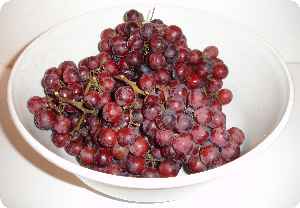 Step 1 - Pick the grapes! (or buy them already picked)
Step 1 - Pick the grapes! (or buy them already picked)
It's fun to go pick your own and you can obviously get better quality ones! You can use Concord grapes, red grapes or other grapes. Whichever you choose, you want flavorful grapes. Plain seedless white/green grapes, for example, have little flavor and make a bland jelly. Most people choose Concord grapes or red grapes. Seedless or with seeds doesn't matter, as the strainer will remove them! I prefer to grow my own; which is really easy - but that does take some space and time.
Above are grapes that I picked at a pick-your-own farm. If you want to pick your own, here is a list and links to the pick your own farms.
Step 2 - How much fruit?
Grape Jelly can ONLY be made in rather small batches - about 6 cups at a time - like the directions on the pectin say, DO NOT increase the recipes or the grape jelly won't "set" (jell, thicken). As mentioned in the Ingredients section; you may use either 5 lbs of fresh grapes or 5 cups of grape juice (either bottled or reconstituted from frozen concentrate) without added sugar. Using grape juice is especially useful if you want to make some grape jelly in December to give away at Christmas!Step 3 - Wash the jars and lids
Now's a good time to get the jars ready, so you won't be rushed later. The dishwasher is fine for the jars; especially if it has a "sanitize" cycle, the water bath processing will sanitize them as well as the contents! If you don't have a dishwasher with a sanitize cycle, you can wash the containers in hot, soapy water and rinse, then sanitize the jars by boiling them 10 minutes, and keep the jars in hot water until they are used. NOTE: If unsanitized jars are used, the product should be processed for 5 more minutes. However, since this additional processing can result in a poor set (runny jelly), it’s better to sanitize the jars.Put the lids into a pan of hot, but not quite boiling water (that's what the manufacturer's recommend) for 5 minutes, and use the magnetic "lid lifter wand" to pull them out.
NOTE: If unsanitized jars are used, the product should be processed for 5 more minutes. However, since this additional processing can result in a poor set (runny jelly), it’s better to sanitize the jars.Put the lids into a pan of hot, but not quite boiling water (that's what the manufacturer's recommend) for 5 minutes, and use the magnetic "lid lifter wand" to pull them out.
Leave the jars in the dishwasher on "heated dry" until you are ready to use them. Keeping them hot will prevent the jars from breaking when you fill them with the hot jelly.
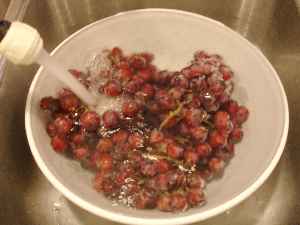 Step 3 -Wash the grapes!
Step 3 -Wash the grapes!
I'm sure you can figure out how to wash the grapes in a large bowl under running plain cold water.
Pick out any stems and leaves that became mixed in!
Check the directions with the pectin; typically, it is 7 cups of sugar to 5 cups of grape juice and one box of regular pectin. You can use about half as much sugar if you use the "no-sugar-needed" pectin. The precise measurements are found in each and every box of pectin sold. Mix the dry pectin with about 1/4 cup of the sugar and keep this separate from the rest of the sugar. If you are not using sugar, you'll just have to stir more vigorously to prevent the pectin from clumping.
Put the grap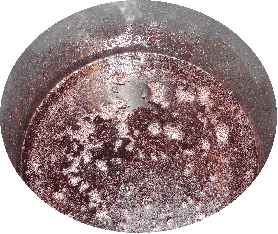 es in a pot and add enough water to just cover the grapes. Put the crushed grapes in a big pot on the stove over medium to high heat (stir often enough to prevent burning) for until it starts to boil, then reduce the heat and simmer for 10 minutes. We just want to soften the skins to help release the juice and break down some of the fruit to help it pass through our juice strainer.
es in a pot and add enough water to just cover the grapes. Put the crushed grapes in a big pot on the stove over medium to high heat (stir often enough to prevent burning) for until it starts to boil, then reduce the heat and simmer for 10 minutes. We just want to soften the skins to help release the juice and break down some of the fruit to help it pass through our juice strainer.
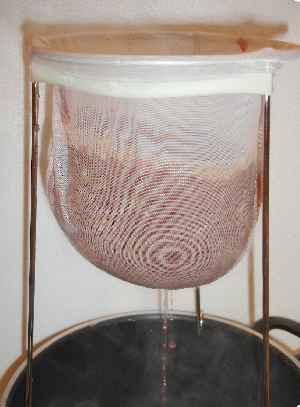 You can either put the soft cooked grapes through a jelly strainer (about $9.00, see ordering at right) which results in the most clear jelly and is easiest to use, or pour them through cheesecloth in a colander. Or if you don't mind chunky jelly, just let the juice stand for 20 minutes, and decant (pour off) the clear liquid to use and leave the solids behind.
You can either put the soft cooked grapes through a jelly strainer (about $9.00, see ordering at right) which results in the most clear jelly and is easiest to use, or pour them through cheesecloth in a colander. Or if you don't mind chunky jelly, just let the juice stand for 20 minutes, and decant (pour off) the clear liquid to use and leave the solids behind.
You may also want to run the crushed cooked grapes through a Foley food mill (about $20 - see this page) BEFORE the jelly strainer - it helps to extract more juice and jet out the large skins that will clog the strainer. It's not necessary, but helps you get the most out of the grapes.
If you need a stopping point and want to finish up the next day, this is a good place. Sometimes, jelly gets crystals, called tartrate crystals, forming in the jelly. They're not harmful and don't affect the taste, but some people don't like the appearance. I rarely even see them! But if you do, let juice stand in a cool place overnight, then strain through two thicknesses of damp cheesecloth to remove any crystals that have formed.
Comments from a visitor on August 22, 2011: "I just thought I would tell you a cost saving item. I use the paint filters at Sherwin Williams paint stores they are so easy and economical. They can also be washed and reused multiple times. Yesterday I worked up about three gallons of grapes and I used the 5 gallon size (they come in all sizes). "
Stir the pectin into the grape juice and put the mix in a big pot on the stove over medium to high heat (stir often enough to prevent burning). It should take about 5 to 10 minutes to get it to a full boil (the kind that cannot be stirred away).Notes about pectin: I usually add about 25% - 30% more pectin (just open another pack and add a little) or else the jelly is runnier than I like. With a little practice, you'll find out exactly how much pectin to get the thickness you like. Another tip: use the low sugar or no-sugar pectin. It cuts the amount of sugar you need from 7 cups per batch to 4 cups. And it tastes even better! On the other hand; I still add some sugar, even with the No-sugar pectin. With no added sugar, the batches always turned out runny and bland. You might want to try using the low sugar recipe with a mixture of sugar and Stevia (or if you prefer, agave, honey or Splenda); that could work, but you do get the best results with sugar. 


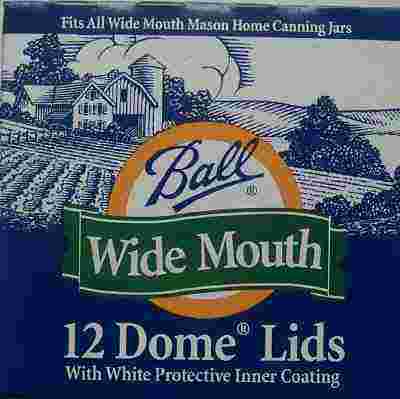
Need lids, rings and replacement jars?
Get them all here, delivered direct to your home, at the best prices on the internet!
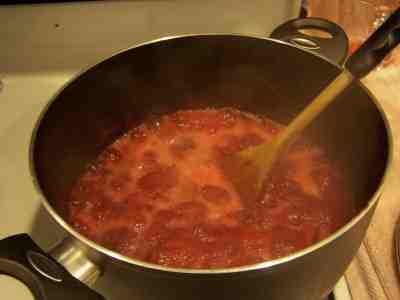 When the grape-pectin mix has reached a full boil, add the rest of the sugar (about 6 and 3/4 cups of sugar per 5 cup batch of grape juice; 4 cups of sugar if you are using the low or no-sugar pectin) and then bring it back to a boil and boil hard for 1 minute.
When the grape-pectin mix has reached a full boil, add the rest of the sugar (about 6 and 3/4 cups of sugar per 5 cup batch of grape juice; 4 cups of sugar if you are using the low or no-sugar pectin) and then bring it back to a boil and boil hard for 1 minute.
I keep a metal tablespoon sitting in a glass of ice water, then take a half spoonful of the mix and let it cool to room temperature on the spoon. If it thickens up to the consistency I like, then I know the jelly is ready. If not, I mix in a little more pectin (about 1/4 to 1/2 of another package) and bring it to a boil again for 1 minute.
Fill them to within ¼-inch of the top, wipe any spilled jelly off the top, seat the lid and tighten the ring around them. Then put them into the boiling water canner!This is where the jar tongs come in really handy!
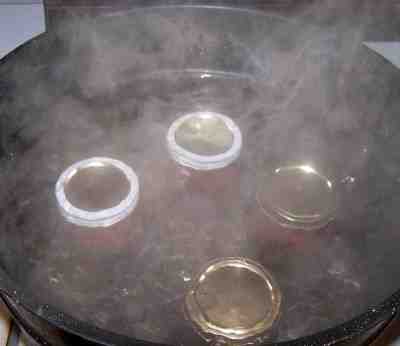 Keep the jars covered with at least 2 inches of water. Keep the water boiling. In general, boil them for 5 minutes, which is what SureJell (the makers of the pectin) recommend. I say "in general" because you have to process (boil) them longer at higher altitudes than sea level, or if you use larger jars, or if you did not sanitize the jars and lids right before using them. The directions inside every box of pectin will tell you exactly - and see the Table below for altitude differences. The directions on the pectin tend to be pretty conservative. Note: Some people don't even boil the jars; they just ladle it hot into hot jars, put the lids and rings on and invert them, but putting the jars in the boiling water bath REALLY helps to reduce spoilage! To me, it makes little sense to put all the working into making the jelly and then not to process the jars to be sure they don't spoil!
Keep the jars covered with at least 2 inches of water. Keep the water boiling. In general, boil them for 5 minutes, which is what SureJell (the makers of the pectin) recommend. I say "in general" because you have to process (boil) them longer at higher altitudes than sea level, or if you use larger jars, or if you did not sanitize the jars and lids right before using them. The directions inside every box of pectin will tell you exactly - and see the Table below for altitude differences. The directions on the pectin tend to be pretty conservative. Note: Some people don't even boil the jars; they just ladle it hot into hot jars, put the lids and rings on and invert them, but putting the jars in the boiling water bath REALLY helps to reduce spoilage! To me, it makes little sense to put all the working into making the jelly and then not to process the jars to be sure they don't spoil!
Lift the jars out of the water with your jar lifter tongs and let them cool without touching or bumping them in a draft-free place (usually takes overnight) You can then remove the rings if you like, but if you leave them on, at least loosen them quite a bit, so they don't rust in place due to trapped moisture. Once the jars are cool, you can check that they are sealed verifying that the lid has been sucked down. Just press in the center, gently, with your finger. If it pops up and down (often making a popping sound), it is not sealed. If you put the jar in the refrigerator right away, you can still use it. Some people replace the lid and reprocess the jar, then that's a bit iffy. If you heat the contents back up, re-jar them (with a new lid) and the full time in the canner, it's usually ok. Once cooled, they're ready to store. I find they last up to 12 months. But after about 6 to 8 months, they get darker in color and start to get runny. They still are safe to eat, but the flavor and texture aren't as good. So eat them in the first 6 months after you prepare them!
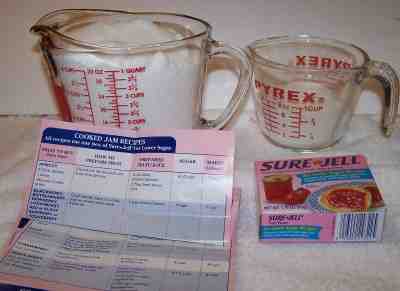 Step 5 - Measure out the sugar
Step 5 - Measure out the sugar
Check the directions with the pectin; typically, it is 7 cups of sugar to 5 cups of grape juice and one box of regular pectin. You can use about half as much sugar if you use the "no-sugar-needed" pectin. The precise measurements are found in each and every box of pectin sold. Mix the dry pectin with about 1/4 cup of the sugar and keep this separate from the rest of the sugar. If you are not using sugar, you'll just have to stir more vigorously to prevent the pectin from clumping.
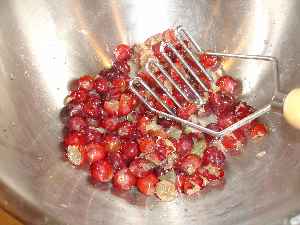 Step 4 - Crush or chop the grapes
Step 4 - Crush or chop the grapes
You mush the grapes to release the juice. A potato masher is useful to help crush them. But if you really want to ,make it easy, just use your food processor or 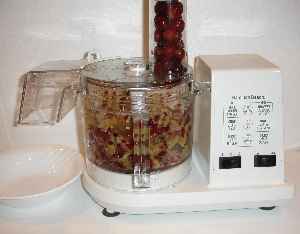 chopper OR a juicer. To make jelly, we'll need to crush them well so we can extract the juice. You'll need about 5 cups of juice.
chopper OR a juicer. To make jelly, we'll need to crush them well so we can extract the juice. You'll need about 5 cups of juice.
 chopper OR a juicer. To make jelly, we'll need to crush them well so we can extract the juice. You'll need about 5 cups of juice.
chopper OR a juicer. To make jelly, we'll need to crush them well so we can extract the juice. You'll need about 5 cups of juice.
If you use a juicer, you can juice the grapes, then skip to step 8.
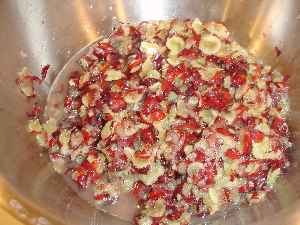 Step 6 - Heat the crushed grapes on the stove
Step 6 - Heat the crushed grapes on the stove
Put the grap es in a pot and add enough water to just cover the grapes. Put the crushed grapes in a big pot on the stove over medium to high heat (stir often enough to prevent burning) for until it starts to boil, then reduce the heat and simmer for 10 minutes. We just want to soften the skins to help release the juice and break down some of the fruit to help it pass through our juice strainer.
es in a pot and add enough water to just cover the grapes. Put the crushed grapes in a big pot on the stove over medium to high heat (stir often enough to prevent burning) for until it starts to boil, then reduce the heat and simmer for 10 minutes. We just want to soften the skins to help release the juice and break down some of the fruit to help it pass through our juice strainer. Step 7 - Sieve the cooked grapes
 You can either put the soft cooked grapes through a jelly strainer (about $9.00, see ordering at right) which results in the most clear jelly and is easiest to use, or pour them through cheesecloth in a colander. Or if you don't mind chunky jelly, just let the juice stand for 20 minutes, and decant (pour off) the clear liquid to use and leave the solids behind.
You can either put the soft cooked grapes through a jelly strainer (about $9.00, see ordering at right) which results in the most clear jelly and is easiest to use, or pour them through cheesecloth in a colander. Or if you don't mind chunky jelly, just let the juice stand for 20 minutes, and decant (pour off) the clear liquid to use and leave the solids behind.You may also want to run the crushed cooked grapes through a Foley food mill (about $20 - see this page) BEFORE the jelly strainer - it helps to extract more juice and jet out the large skins that will clog the strainer. It's not necessary, but helps you get the most out of the grapes.
If you need a stopping point and want to finish up the next day, this is a good place. Sometimes, jelly gets crystals, called tartrate crystals, forming in the jelly. They're not harmful and don't affect the taste, but some people don't like the appearance. I rarely even see them! But if you do, let juice stand in a cool place overnight, then strain through two thicknesses of damp cheesecloth to remove any crystals that have formed.
 |
 Step 8 - Add the pectin to the hot strained juice and bring to a full boil
Step 8 - Add the pectin to the hot strained juice and bring to a full boil
Stir the pectin into the grape juice and put the mix in a big pot on the stove over medium to high heat (stir often enough to prevent burning). It should take about 5 to 10 minutes to get it to a full boil (the kind that cannot be stirred away).Notes about pectin: I usually add about 25% - 30% more pectin (just open another pack and add a little) or else the jelly is runnier than I like. With a little practice, you'll find out exactly how much pectin to get the thickness you like. Another tip: use the low sugar or no-sugar pectin. It cuts the amount of sugar you need from 7 cups per batch to 4 cups. And it tastes even better! On the other hand; I still add some sugar, even with the No-sugar pectin. With no added sugar, the batches always turned out runny and bland. You might want to try using the low sugar recipe with a mixture of sugar and Stevia (or if you prefer, agave, honey or Splenda); that could work, but you do get the best results with sugar. 
Is your jelly too runny? Pectin enables you to turn out perfectly set jelly every time. Made from natural apples, there are also natural no-sugar pectins that allow you to reduce the sugar you add by half or even eliminate sugar.!
Get them all here at the best prices on the internet!
Get them all here at the best prices on the internet!
Step 9 - Get the lids warming in hot (but not boiling) water
If you didn't do so already, put the lids into a pan of hot water for at least several minutes; to soften up the gummed surface and clean the lids.


Need lids, rings and replacement jars?
Get them all here, delivered direct to your home, at the best prices on the internet!
Step 10 - Add the remaining sugar and bring to a boil
 When the grape-pectin mix has reached a full boil, add the rest of the sugar (about 6 and 3/4 cups of sugar per 5 cup batch of grape juice; 4 cups of sugar if you are using the low or no-sugar pectin) and then bring it back to a boil and boil hard for 1 minute.
When the grape-pectin mix has reached a full boil, add the rest of the sugar (about 6 and 3/4 cups of sugar per 5 cup batch of grape juice; 4 cups of sugar if you are using the low or no-sugar pectin) and then bring it back to a boil and boil hard for 1 minute.
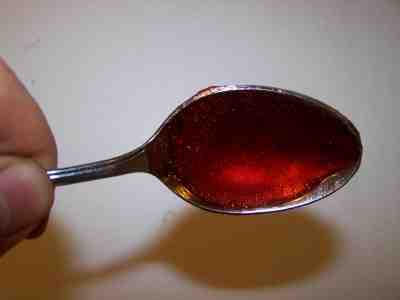 Step 11 - Testing for "jell" (thickness)
Step 11 - Testing for "jell" (thickness)
I keep a metal tablespoon sitting in a glass of ice water, then take a half spoonful of the mix and let it cool to room temperature on the spoon. If it thickens up to the consistency I like, then I know the jelly is ready. If not, I mix in a little more pectin (about 1/4 to 1/2 of another package) and bring it to a boil again for 1 minute.
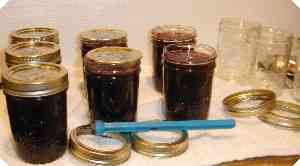 Step 12 - Fill the jars and put the lid and rings on
Step 12 - Fill the jars and put the lid and rings on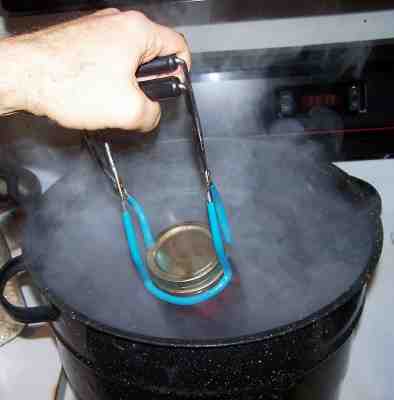
Fill them to within ¼-inch of the top, wipe any spilled jelly off the top, seat the lid and tighten the ring around them. Then put them into the boiling water canner!This is where the jar tongs come in really handy!Step 13 - Process the jars in the boiling water bath
 Keep the jars covered with at least 2 inches of water. Keep the water boiling. In general, boil them for 5 minutes, which is what SureJell (the makers of the pectin) recommend. I say "in general" because you have to process (boil) them longer at higher altitudes than sea level, or if you use larger jars, or if you did not sanitize the jars and lids right before using them. The directions inside every box of pectin will tell you exactly - and see the Table below for altitude differences. The directions on the pectin tend to be pretty conservative. Note: Some people don't even boil the jars; they just ladle it hot into hot jars, put the lids and rings on and invert them, but putting the jars in the boiling water bath REALLY helps to reduce spoilage! To me, it makes little sense to put all the working into making the jelly and then not to process the jars to be sure they don't spoil!
Keep the jars covered with at least 2 inches of water. Keep the water boiling. In general, boil them for 5 minutes, which is what SureJell (the makers of the pectin) recommend. I say "in general" because you have to process (boil) them longer at higher altitudes than sea level, or if you use larger jars, or if you did not sanitize the jars and lids right before using them. The directions inside every box of pectin will tell you exactly - and see the Table below for altitude differences. The directions on the pectin tend to be pretty conservative. Note: Some people don't even boil the jars; they just ladle it hot into hot jars, put the lids and rings on and invert them, but putting the jars in the boiling water bath REALLY helps to reduce spoilage! To me, it makes little sense to put all the working into making the jelly and then not to process the jars to be sure they don't spoil!| Table 1. Recommended process time for Grape Jelly in a boiling water canner. | ||||
| Process Time at Altitudes of | ||||
| Style of Pack | Jar Size | 0 - 1,000 ft | 1,001 - 6,000 ft | Above 6,000 ft |
| Hot | Half-pints or Pints | 5 min | 10 | 15 |
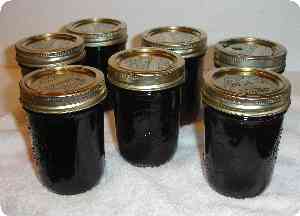 Step 14 - Remove and cool the jars - Done!
Step 14 - Remove and cool the jars - Done!
Comments
Post a Comment